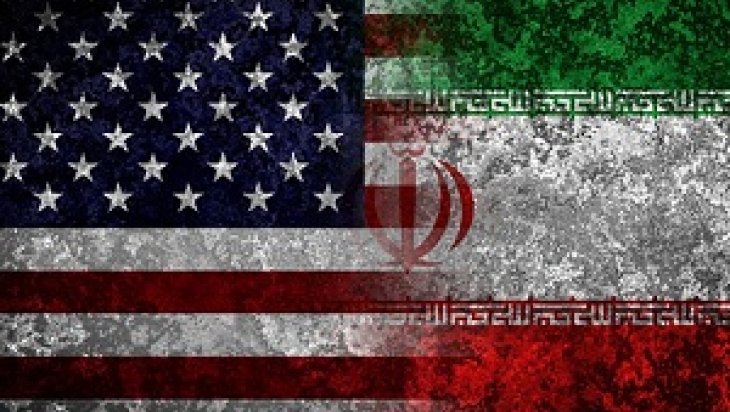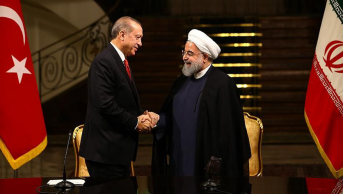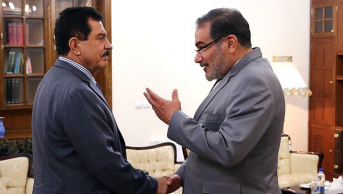The United States and Iran: Partners or Enemies?

Recently, the interests of the US and Iran have begun to overlap over an increasing number of issues. For instance, it has not been an American priority for a long time to overthrow the Assad regime in Syria, to which Iran declared its supportuntil the last moment arguing that ‘the defense of Damascus means the defense of Tehran.’ Thesupportfor the governmentof Baghdad and the coordination between the Iraqi army and the Hashd al-Shaabi (Popular Mobilization Forces) are other samples of the overlapping American and Iranian interests and policies. The nuclear deal that was reached in July 2015 has led some speculations that ‘the United States has sided with Iran.’ However, there are very rigid divergences between the two countries, and incompatible red lines such as their approaches to Israel.
How can we comprehend this relationship, which can sometimes be defined as indirect co-operation, sometimes intersection of interests? Could we talk about an implicit partnership between Tehran and Washington in the Middle East, who are apparently hostile since the 1979 Revolution?
From 1979 Revolution to the Nuclear Deal
Official discourses and positions are well-known... There are no diplomatic relations between Iran and the U.S. since the revolutionary studentsoccupied the US Embassy in Tehran and took the diplomats hostage on November 4, 1979. Moreover, since then, the two states have viewed each other as enemy and principal threat to their security. Anti-imperialism, which is one of the main slogans of the Iranian Revolution, is now largely turned into anti-Americanism and anti-Zionism. November 4th, has been commemorated every year in Iran as the 'National Day of Fight Against Global Arrogance,' and is the most important symbol of anti-Americanism. In addition to being an imperialist power, the United States is seen as a relentless enemy of the 'Islamic Revolution'.
The United States, on the other hand, has designated Iran as a ‘state sponsor of terrorism’, and views it as ‘an ongoing threat to US national interests’ because of its nuclear program, development of advanced military capabilities, and its regional policies. The tension between the two states peaked when the US President Bush declared Iran as part of ‘axis of evil’ and pursued regime change policy towards Tehran. As to President Obama, even though he gave up the regime change policy, he increased military pressure on Iran by maintaining that ‘all options are on the table.’ The nuclear deal of July 2015 has begun to change this picture, and the US-Iranian tension has relatively calmed down.
Converging Points of Iranian and American Policies
Apparently there is ‘hostility’ between the US and Iran, but their respective policies with regard to some developments in the Middle East raise the question of whether the two states are in a tacit alliance.
The most important argument of those who think in this direction is ‘thehandover of Iraq to Iran in a golden tray.’ Accordingly, the US opened the way for Iran by overthrowing the Saddam Hussein regime and establishing a political structure and government there in the interests of Iran. By utilizing this opportunity very well, Iran has increased its influence in the region.
The ambivalent policies of the United States towards the Syrian crisis helped Tehran to increase its influence over Syria. Lastly, the presidential crisis, which has been ongoing for over two years in Lebanon, ended with the presidency of Michel Aoun, who has been supported by Iran and Hezbollah, at early November.Inthe words of Iranian Foreign Minister Zarif, Iran has reached 'an undeniable influence on recent developments in the region and the world as the region’s top power.'
Many who oppose the Tehran regime, or are troubled with the rise of Iran's regional power, are convinced that direct or indirect support of the United States helped the rise of Iranian regional power. According to their view, the tacit co-operation between Tehran and Washington in the Middle East has become clear after the nuclear deal. It is claimed that the US and Iran negotiated not only the nuclear issue, but also the regional issues.Eventually, 'America has taken Iran’s side’ after the nuclear deal, as stated by well-known journalist Robert Fisk.According to this view, Washington has sided with the Shiites, that arethe central government in Baghdad and Iran, which are now regarded as relatively moderatein terms of American interests in order to offset the radical 'Sunnite' movements supposedly represented by ISIS and other extremists. Likewise, according to this view, the insistence of the Obama administration on the nuclear deal against the severe criticisms of Israel and the Gulf stateshas stemmed from the fact that it regarded Iran as a potential partner in the solution of regional issues.
Indeed, the American officials who once used to view the rising influence of Tehran in the region as a threat and strove for containing it, called Iranian government to play a more active and constructive role after the nuclear deal in resolving regional issues. Moreover, President Obama has avoided granting security guarantee, that is to sign a defense pact,asked by the Persian Gulf countries, whose concerns for security have been amplified after the nuclear deal. Instead, arguing that ‘None of our nations have an interest in an open-ended conflict with Iran,’ he advised the Gulf leaders ‘find an effective way to share the neighborhood and institute some sort of cold peace’ with Iran.But these statements did not mean that the US abandoned its partners in the Gulf. Indeed, in his speech, Obama noted the importance of security cooperation between the Gulf countries and the United States, and said that his country would act together with the Gulf countries against external threats.
Iraq, Syria, Kurds, ISIS: the common interests?
It is true that, despite the ostensible animosity between the two, Iranian policies towards the Middle East have sometimes overlapped with US interests and approaches.The interests of the two countries converged, above all, on the overthrow of the Saddam Hussein administration and the establishment of a federal and 'democratic' administration in Iraq. But, only an indirect cooperation can be mentioned here. While Iran was silent in the face of the invasion of Iraq, Tehran's Iraqi allies (Kurdish and Shiite groups linked to Iran) were supporters of the American occupation. Once a dialogue was initiated between the two countries to provide security in Baghdad, but it did not last long.
One of the points where the interests of the two countries were convergedas in the example of Iraq was the establishment of a relatively strong government in Baghdad. However, the governments that came to power after the establishment of the new administration in Iraq caught between Iran and the United States. Both Tehran and Washington have beenbusy with pressuring the Baghdad government in different directions.
Likewise, both countries seemingly defend the territorial integrity of Iraq. However, the US accuses Iran of destabilizing Iraq with denominational policies, while Iranian officials claim that the US administration is trying to dismantle Syria and Iraq. For this reason, the growing relations between the United States and Kurdish movements both in Iraq and Syria is disturbing Iran. Although Iran itself supports the Kurdish movements in the region to some extent, it wants the Kurds to act on its own control. But, American cooperation with both the PYD and the Iraqi Kurdistan Regional Government raises Iranian anxieties with regardto the future of these movements as well as the countries concerned.
Another point that the interests of Iran and the United States overlap in the region is the fight against terrorism and extremist movements such as ISIS and Nusra Front that have emerged in Iraq and Syria. Especially when the ISIS captured some of the Iraqi landsin June 2014 and turned into an actor that was threatening the entire Middle East, the way for a potential cooperation between Iran and the USA was opened up. John Kerry, Secretary of State of the US administration said in an interview on June 16th, “We're open to discussions if there is something constructive that can be contributed by Iran (with regard to Iraq).' After then his deputy, William Burns, who had joined the nuclear negotiations in Vienna at the time,talked to Iranian diplomats about possible cooperation between the two countries in order to stop ISIS and ensure stability in Iraq. But this meeting was a short one, and they did not mentionanymilitary and strategic cooperation.
For the US, the fight against terrorist organizations in the Middle East is an extension of the war against global terrorism, which had started after the September 11 attacks. For Tehran, the fight against extremist movements and 'terrorism' has provided, above all, a political, legal and moral ground for fighting against those organizations that threatenthe regional interests of Iran.
Much has been written about the role of the ISIS threat inuniting the interests of Tehran and Washington in Iraq. Both countries supported both the central Iraqi government and the Iraqi Kurdistan Regional Government against the ISIS. But despite this shared interest, it is difficult to say that there is a direct link between the two states, especially in the fight against ISIS. While the American administration was expecting abargai on the formation of the new Iraqi government, Iran provided military support to Baghdad and Arbil. Iranian Leader Ayatollah Khamenei said in his speech on June 22, “We are strongly against the interference of the US and others in Iraq’s internal affairs and do not approve of it, because we believe that the Iraqi government, nation and religious authorities are capable of ending this sedition and will end it.”According to his view, the reason for the crisis in Iraq was that the 'arrogant powers' that “want to use the remnants of Saddam’s regime and takfiri [ISIS] extremists to deprive Iraq of stability and tranquility.”
The coalition forces led by the United States, however, went into military action against the ISIS in August. The Iranian involvement in the coalition was on the agenda for a while, however, both the US and Iran have rejected the official partnership within the coalition.In addition to “ineffective” air strikes of the coalition, American warnings implying that the fight against ISIS might take years, has caused Iranian leaders to doubt with American intentions.
Indirect Cooperation: Hashd al-Shaabi
However, the military coordination between the coalition forces and the Iraqi army and the Hashd al-Shaabi, which was supported by Iran and counseled by Iranian officers,could be described as an indirect cooperation between Iran and the US. This indirect cooperation is being conducted through the government of Baghdad. Despite the fact that there are many American and Iranian military elements in the area, the lack of tension between them suggests that Iran and the US indirectly coordinated their movements if at all.
However, the fact that the most influential instruments of Iran in the fight against ISIS, the Qods Force,as well asIran’sallies in the field, Hezbollah and Ketaib-i Hezbollah, are regarded as terrorist organizationsby the United States, prevent possible cooperation between the two states in fighting against extremism and terrorism. Indeed, the indirect cooperation between these two countries that are constantly suspicious of each other's intentions is limited with providing support to the government in Baghdadand defeating ISIS. If ISIS could be completely removed from Iraq, the competition between the two countries to influence the Baghdad administration will continue.
Unlike the case in Iraq, the ISIS threat did not lead to cooperation between Iran and the US in Syria. There is coordination between the Assad administration and the coalition forces, but it is hard to claim that it is equal toan indirectIran-US cooperation. Iran, which has already actively supportedthe Assad administration, engaged in astrategic partnership with Russia in the case of Syria. The cooperation between Tehran and Washington on the Syrian issue was limited only toinviting Iran to some inconclusive international conferences.
Is American-Iranian cooperation possible?
There are many people both in Iran and in the United States who advocate normalization of relations, and even cooperation at regional level. According to them, the interests of the United States and Iran coincide in many ways, from energy issues to the fight against radicalism. However, the reasons such as political considerations and balances in the two countries in addition to their contradictory political commitments, and ideological differences do not allow such a radical transformation in relations between the two countries.
Iranian leader Ayatollah Khamenei has banned talks with the US on any issue after the nuclear deal. The Revolutionary Guards seized a group of American soldiers in January 2016, when the nuclear deal entered into force, on the grounds that they violated Iran's territorial waters. Since then, military tension has increased between the two countries in the Persian Gulf. Additionally, there are serious problems with regard to the removal of sanctions in the framework of the nuclear agreement. For this reasons, Iranian officials accuse the United States of not fulfilling requirements of the agreement. Finally, the new US President-elect Donald Trump claimed, during the election campaign, that the nuclear deal was a bad deal, and he pledged to revise the deal as soon as he comes to power. Moreover, Trump is not the only American official whosays that the nuclear deal is a bad agreement. Even the Obama administration that agreed with Iran on the nuclear issue, have continued to pressurize Iran through various sanctions.
The US administration still sees Iran as one of the states that sponsor international terrorism. The Qods Force of the Islamic Revolutionary Guards Corps is under sanctions for supporting terrorism. Numerous Iranian political leaders, soldiers, institutions, and companies are targeted by the American sanctions allegedly for their support for the Assad leadership in Syria, destabilizing Iraq, playingcritical roles in nuclear programs and arms programs, human rights abuses and terrorism, and so on. The 'Iran Sanctions Act', which prevents American companies and third-country companies from investing in the Iranian energy market, is still in force. In a letter to Congress on November 4, 2016, Obama stated that relations with Iran has not return to normal, and he asked the continuation of the "national emergency" regarding Iran.
Some of the existing engagements and commitments of the US and Iran in the Middle East, inevitably lead to a confrontation between two countries. First of all, one of the basic elements of American regional policy is the security of Israel. Any threat to Israel's security is considered as a threat to American interests. Though some disagreements may arise between the American governments and the Israeli governments, as it is the case under President Obama, this policy does not change. In contrast, Israel is one of Iran's overtenemies. For this reason, it vigorously supports Hezbollah and the Palestinian resistance organizations, mainly those that are loyal to Tehran for sure. The current commitments and policies of Iran and the United States with regard to the Palestinian issue result in the persistence of animosity between the two countries.
Likewise, while Iran has stood beside the Assad regime, the US administration has supported its opponents since the inception of anti-regime rebellions in Syria. What has happened in Yemen, on the other hand, was the contrary of this situation. While the US has stood beside the Hadi government supported by Saudi Arabia and the Gulf countries, Iran has supported insurgent Huthis. Indeed, the attitude of Iran during the Arab uprisings was quite simple; to support anti-Americans wherever they are. For Iranians, anti-Americanism is the basic indicator to provethe 'Islamicity' of a given movement. As a matter of fact, Iran has named its relations of alliance in the region as the 'axis of resistance' against American policies and Israel.
In conclusion, it is hard to claim that there is a tacit alliance or partnership between Iran and the US. However, it is also clear that the strategic interests of the two countries in the current contexts overlap on some issues such as supporting the Baghdad government and Hashd al-Shaabi, keeping Assad in power, and fighting against ISIS.
As the newly elected US President Trump stated, “the policies pursued by the US in the region” may have contributed to “the strengthening of Iran.” But it is not an outcome that is designed or intended by the American administration. As the Iranian authorities have stressed from time to time, the policies that have been pursued by the US and other actors, and their 'mistakes' in the region, especially in Iraq and Syria, have opened some doors for Iran in the region.
Interests of the two countries may overlap or they may engage in occasional cooperation, but it does not mean that Iran and the US act together at the regional level.











